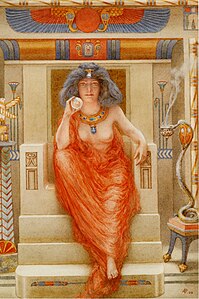Armand Point

Armand Point (23 March 1860
Personal life
Point was born in Algiers,
Early career
Point's earliest works were
Move towards Idealism

Point was influenced by
-
Thursday's walk in the fields, 1888. Musée des Augustins Toulouse
-
Ame d’Automne (Autumn Soul). Pastel on brown paper, c. 1890s. Model probably Hélène Linder[4]
-
Hélène Linder, 1893 drawing
-
A Portrait of Madame Berthelot. Charcoal and coloured chalks, 1895. Private collection
-
Remeniscing by the Pond, c. 1900
-
Woman with cherry blossom, undated
Symbolism

Soon, Point was moving towards fully fledged Symbolism. He made a determined effort to reject the modern world and the realism of
Subjects at this time were usually mythological, such as his 1897 The Siren which included a typical Symbolist
Atelier de Haute-Claire

From 1896 to 1901 Point lived in
The Symbolist journal L'Ermitage criticised the works of the Haute-Claire group for amounting to religious icons fit only for reverence in a case in a museum and having little to do with the France of today. One such ornate object was the Coffret d'Ophélie (Ophelia Box), a box in the form of a
A diverse group of people visited Haute-Claire, including Oscar Wilde just months before his death in 1900. Wilde was in exile in France following imprisonment in Britain.[5]
Early and orientalist works
Symbolist works
-
Eternal Chimera. Lead pencil and pastel, c. 1895.
-
Golden legend. (Fr. Légende dorée) Lithograph, 1897.
-
The Siren. 1897.[3]
-
Dance of Salome. Oil on canvas, 1898.[2]
Later works
-
Portrait of an Egyptian goddess, probably Isis. Watercolour, 1909.
-
Bust of a woman in a landscape. Pencil on paper, 1910. Walters Art Museum, Baltimore.[18]
-
The Judgement of Paris. Oil on canvas, 1910 or 1911.[19]
-
Apollo and Daphne. Oil on canvas, 1919.
References
- ^ Armand Point memoireafriquedunord.net 2014. Retrieved 20 June 2014.
- ^ a b c d e f g "Point, Armand." Benezit Dictionary of Artists, Oxford Art Online, Oxford University Press. Retrieved 20 June 2014.
- ^ a b c d e f g h i "Point, Armand." Colette E. Bidon, Grove Art on Line, Oxford Art Online, Oxford University Press. Retrieved 20 June 2014.
- ^ a b Âme d’Automne (Autumn Soul) Stephen Ongpin Fine Art, 2014. Retrieved 2 July 2014. Archived here.
- ^ ISBN 978-0-520-07768-3.
- ^ ISBN 071481590X
- ISBN 9781443823920
- ISBN 0500201250
- ^ Lucie-Smith, 1972, p. 54.
- ISBN 978-0-226-51018-7.
- ^ Adventures in the Print Trade Neil Philip, 26 February 2009. Retrieved 22 June 2014.
- ^ Lucie-Smith, 1972, p. 44.
- ^ a b La colonie d'Haute-Claire: artisanat et nostalgie L’Histoire par l’image, 2014. Retrieved 22 June 2014.
- ^ Armand Point Coffret d'Ophélie vers 1903 Musée d'Orsay, 2014. Retrieved 23 June 2014.
- ^ Armand Point Coffret aux serpents entre 1897 et 1899 Musée d'Orsay, 2014. Retrieved 23 June 2014.
- ^ "La Joie des choses". CNAP. Retrieved 15 July 2022.
- ^ Arab Weaver by Armand Point BBC Your Paintings, 2014. Retrieved 20 June 2014.
- ^ Bust of a Maiden in a Landscape Walters Art Museum, 2014. Retrieved 17 July 2014.
- ^ Armand Point Le jugement de Pâris Musée d'Orsay, 2014. Retrieved 23 June 2014.
Further reading
- Doré, Robert. (2010) Armand Point: De l'Orientalisme au Symbolisme: 1861–1932. Paris: B. Giovanangeli. ISBN 9782758700661
- Fort, P., C. Mauclair, S. Merrill et al. "Armand Point et son oeuvre", La Plume, special issue, Paris 1901.
- Jumeau-Lafond, Jean-David. (1999) Les Peintres de L'âme, le Symbolisme idéaliste en France. Gent: Snoeck-Ducaju & Zoon. ISBN 9789053252062


![Ame d’Automne (Autumn Soul). Pastel on brown paper, c. 1890s. Model probably Hélène Linder[4]](http://upload.wikimedia.org/wikipedia/commons/thumb/4/4c/Ame_d%E2%80%99Automne_%28Autumn_Soul%29_by_Armand_Point.jpg/120px-Ame_d%E2%80%99Automne_%28Autumn_Soul%29_by_Armand_Point.jpg)




![La Joie des choses. 1884.[16]](http://upload.wikimedia.org/wikipedia/commons/thumb/1/12/Armand_Point-La_Joie_des_choses-Mus%C3%A9e_des_beaux-arts_de_Nancy.jpg/198px-Armand_Point-La_Joie_des_choses-Mus%C3%A9e_des_beaux-arts_de_Nancy.jpg)


![Arab Weaver. 1886.[17]](http://upload.wikimedia.org/wikipedia/commons/thumb/4/49/Arab_Weaver_by_Armand_Point_1886.jpg/164px-Arab_Weaver_by_Armand_Point_1886.jpg)


![The Siren. 1897.[3]](http://upload.wikimedia.org/wikipedia/commons/thumb/f/f9/Armand_Point_-_The_Siren%2C_1897.jpg/209px-Armand_Point_-_The_Siren%2C_1897.jpg)
![Dance of Salome. Oil on canvas, 1898.[2]](http://upload.wikimedia.org/wikipedia/commons/thumb/f/fd/PointArmandDanceOftheSevenVeils.jpg/182px-PointArmandDanceOftheSevenVeils.jpg)

![Bust of a woman in a landscape. Pencil on paper, 1910. Walters Art Museum, Baltimore.[18]](http://upload.wikimedia.org/wikipedia/commons/thumb/7/77/Armand_Point_-_Bust_of_a_Maiden_in_a_Landscape_-_Walters_372801.jpg/194px-Armand_Point_-_Bust_of_a_Maiden_in_a_Landscape_-_Walters_372801.jpg)
![The Judgement of Paris. Oil on canvas, 1910 or 1911.[19]](http://upload.wikimedia.org/wikipedia/commons/thumb/a/a0/Armand_Point_The_Judgement_of_Paris_c._1910.jpg/363px-Armand_Point_The_Judgement_of_Paris_c._1910.jpg)
